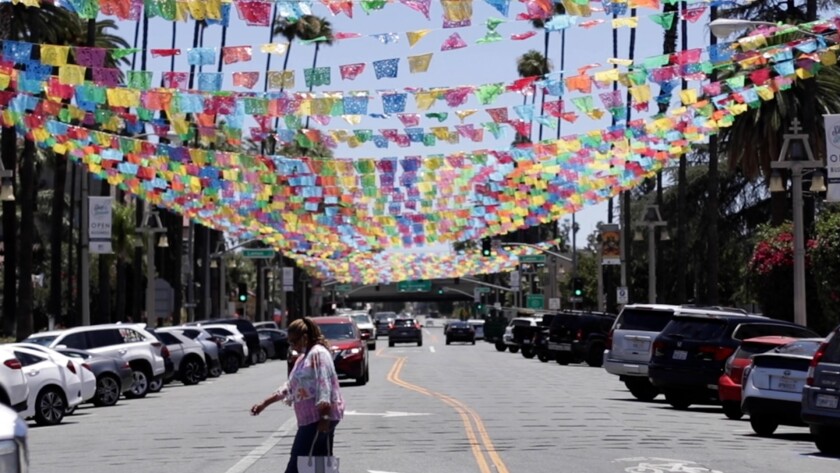My concepts concerning the Inland Empire have all the time been seeded with a prickly skepticism.
So far as I used to be involved, passing by means of cities like Rialto, Colton and Jurupa Valley alongside Interstate 10 and State Route 60 was a obligatory inconvenience on the best way to the desert — not an opportunity to be taught one thing about life in America.
However I used to be intrigued by the latest U.S. census figures displaying the Inland Empire to be one of many fastest-growing areas within the nation and that waves of Black and brown transplants, many from Los Angeles and Southern California’s different city facilities, have pushed a cultural transformation that’s been a long time within the making.
The inhabitants has swelled to 4.6 million individuals unfold throughout Riverside and San Bernardino counties — and an space that was as soon as identified for its whiteness is now about 70% individuals of coloration.
The presence of Black and brown faces isn’t new, however once I got down to perceive why so many are packing up and transferring to the Inland Empire now, I discovered that it wasn’t just because the area is thought to be a bastion of inexpensive housing in dear Southern California.
MY COUNTRY
As a Black man in America, I’ve all the time struggled to embrace a rustic that promotes the beliefs of justice and equality however by no means totally owns as much as its darkish historical past of bigotry, inequality and injustice.
Now, greater than any time in current historical past, the nation appears divided over this enduring contradiction as we confront the gap between aspiration and actuality. Be a part of me as I discover the issues that bind us, make sense of the issues that tear us aside and seek for indicators of therapeutic. That is a part of an ongoing sequence we’re calling “My Nation.”
— Tyrone Beason
There was one thing else — a craving which you could’t simply measure in numbers.
Many times, residents expressed a burning want for a metaphorical timeout from the relentless strain and tempo of life in Southern California — even when that meant placing down roots in cities and cities between the ocean and the desert that many could be hard-pressed to pinpoint on a map.
I really feel like America’s lurching towards a breaking level. Violent crime and racist assaults have been on the rise throughout the U.S. in the previous few years, and mass shootings with no less than 4 victims killed or wounded are a grim every day incidence — this 12 months there have been 360 as of July 23, in accordance with the Gun Violence Archive, a web-based tracker.
In an unsettled nation riven by political divisions and tradition wars, many Individuals have seemingly misplaced their skill to let down their guard and join with each other.
However out right here among the many bone-dry arroyos and housing developments with gently winding lanes, the “craziness” of metro L.A. appears a world away, one younger Black couple say as they push a child stroller down a road lined with banners promoting new houses in Beaumont — 80 miles east of the massive metropolis.
To flee the every day grind that comes with residing within the huge metropolis, individuals of coloration are discovering peace within the Inland Empire within the seek for their American dream.
One other newcomer, Manuel Gutierrez, appears to be like carefree as he grills spicy entire chickens at his roadside Mexican road meals stand surrounded by horse ranches in Moreno Valley, close to Riverside.
Gutierrez, 33, gives up a single phrase to elucidate why, in addition to low cost land, it made sense to depart the group the place he grew up in South-Central L.A. and begin over within the Inland Empire.
“Peace.”

The late Sacramento-born author Joan Didion as soon as described the Inland Empire as “a harsher California” stricken by nerve-racking Santa Ana winds, lethal wildfires, a boom-and-bust economic system and a menacing vacancy in some stretches.
What little I understood concerning the space got here from information clippings about white supremacist rallies, and tales concerning the heyday of Route 66, when badlands had been lined in chaparral and Black individuals risked being attacked in sunset cities merely for getting caught inside metropolis limits after darkish.
I drive north alongside two-lane roads that wind between town of Moreno Valley and the San Bernardino Valley and am transported to a bygone Golden State. Blossom-scented orange groves have been planted so near the asphalt that somebody within the passenger seat might decide the fruit from the automotive.
Each mile or so, indicators warn of untamed burros, and every now and then, I spot herds of the big-eared animals grazing by the street, alarmingly near rushing site visitors.
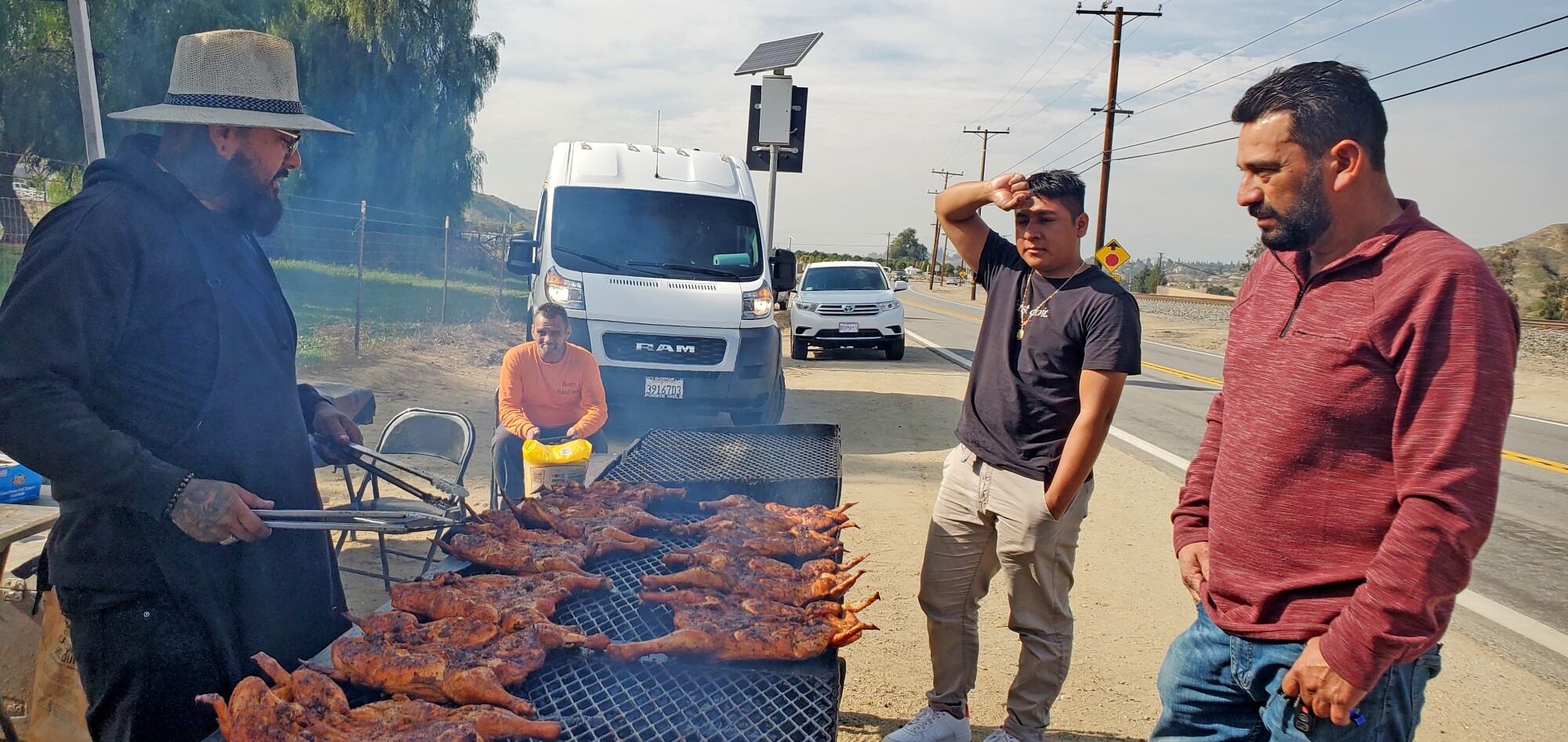
Manuel Gutierrez, left, previously of South-Central L.A., moved to the Inland Empire partly for its peaceable environment.
(Tyrone Beason / Los Angeles Occasions)
It’s a disorienting scene, however the Outdated West vibe isn’t the one factor that endures.
Democrats might have made historic positive aspects on this area because of demographic traits, however as I transfer from metropolis to metropolis I lose monitor of the variety of “Let’s go Brandon” flags I see flying in entrance of houses and from the again of pickup vans, an esoteric dig on the Democrat who received the 2020 election. I’m greatly surprised by a banner within the entrance yard of 1 home that makes the proprietor’s disdain towards President Biden exhausting to misread: “Trump is my president.”
And but, regardless of indicators this may not be a welcoming surroundings, individuals of coloration are drawn right here. The American dream can manifest in stunning locations.
Fatima and Arthur Nelson II had their very own reservations earlier than they moved with their three youngsters in early 2021 from Lengthy Seaside to Moreno Valley, a metropolis of about 215,000 the place residents journey horses on the streets and hillside trails.
However their new metropolis’s racial range — which was lacking of their outdated neighborhood — shocked them.
“It felt like a homecoming in a means,” says Fatima, 47, a group engagement specialist at UC Riverside’s Middle for Social Innovation. “Swiftly, we entered this Black group the place there have been all of those Black owners, which is a little bit of a unicorn in Lengthy Seaside. I see much more shades and colours out right here.”
The household’s ranch-style house — in a various middle-class neighborhood of older single-family homes — has excessive ceilings and an enormous yard. The home will not be fancy, Fatima says, nevertheless it’s obtained “wonderful bones” and was inside the household’s price range.
Fatima has discovered one thing extra elusive since transferring in — an sudden solitude.
“After I go house, it’s prefer it’s horns and sirens and the neighbors screaming subsequent door,” Fatima says of Lengthy Seaside, the place she grew up. “I nearly really feel responsible as a result of I really feel like we have now fared so effectively.”

Orange groves thrive subsequent to asphalt exterior Moreno Valley. Individuals are more and more drawn to the realm, and never just for more-affordable housing.
(Gina Ferazzi / Los Angeles Occasions)
Arthur, a supervisor at a logistics firm, couldn’t see at first how his household would adapt to life within the Inland Empire. They’d solely lived in crowded city areas — his hometown of Philadelphia, Jersey Metropolis, N.J., and Lengthy Seaside. The final 12 months and a half had been a revelation.
“Generally in city settings, with every thing that metropolis dwelling entails — typically you assume that that’s an omnipresent actuality,” says Arthur, 46.
In contrast, he says that in Moreno Valley he’s skilled that different aspect of life he knew was there “however by no means loved.”
“I do know that’s what’s contributed to us being at peace in these troubled occasions,” Fatima says of their new group.
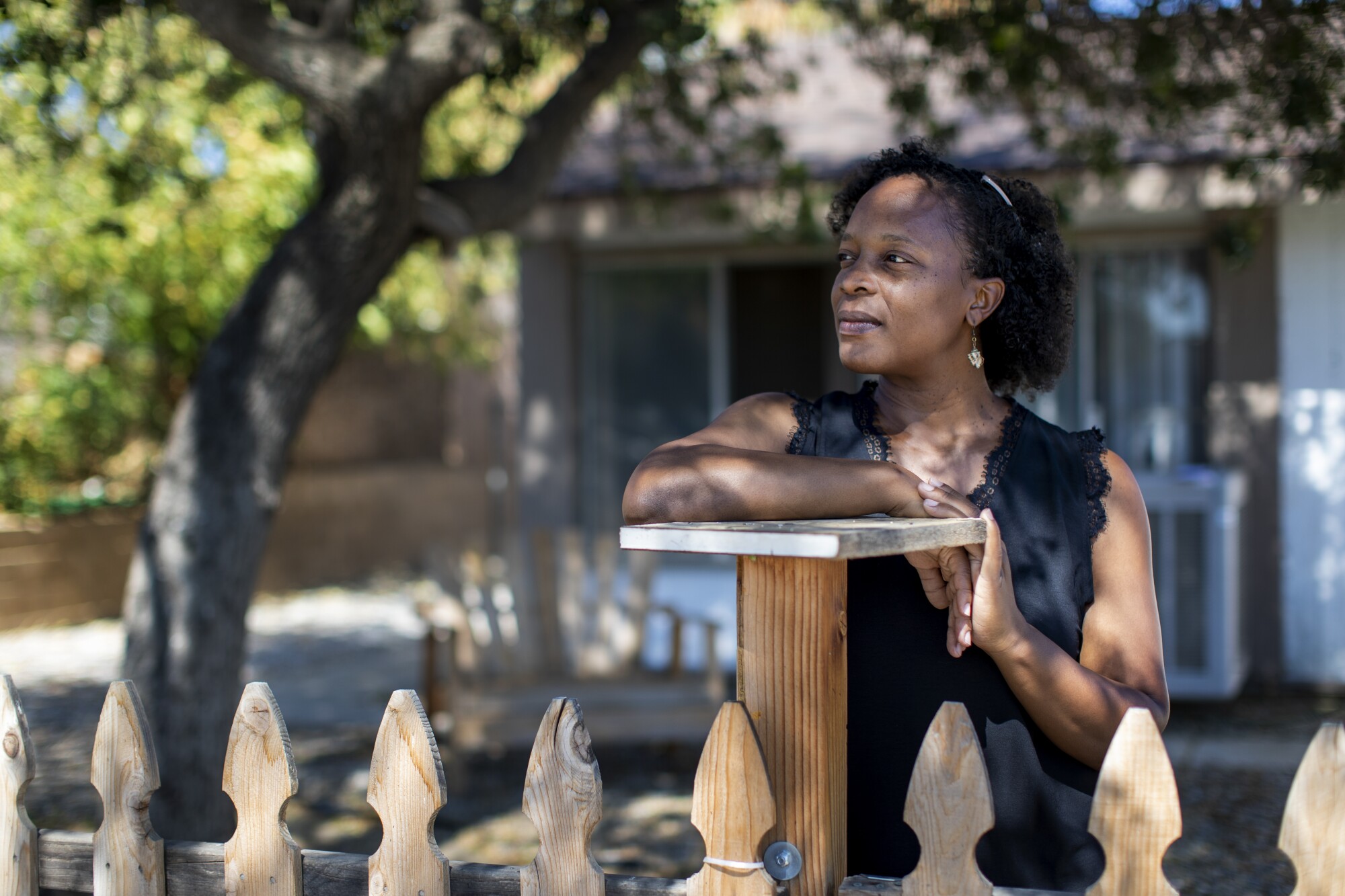
“It felt like a homecoming in a means,” Fatima Nelson says of her household’s transfer from Lengthy Seaside to Moreno Valley, the place she sees “much more shades and colours.”
(Gina Ferazzi / Los Angeles Occasions)
Throughout certainly one of my visits, their son Arthur Nelson III sits subsequent to Fatima on the sofa as she explains how the transfer had benefited the couple’s three youngsters: Tariq, 4; Arthur, 8, and Julia,15.
In Lengthy Seaside, the 2 older youngsters attended wonderful faculties however they had been among the many few college students of coloration. The Nelsons noticed Arthur and Julia struggling in school and having a tough time forming friendships amid the cultural isolation.
“My husband and I made a decision that we’ll traumatize them no extra” by maintaining them in faculties the place few appeared like them, Fatima says.
Son Arthur now attends an elementary faculty the place Black youngsters make up 1 / 4 of the coed physique.
Watching him come into his personal throughout his youth soccer video games with the Inland Empire Hornets, permitting her daughter to stroll house from faculty alone, Fatima says, are simply the form of experiences she and her husband dreamed of after they determined to rebuild their lives right here.
“On the one aspect you assume that it’s tremendous boring and there’s nothing to do and also you simply go loopy another way,” Arthur says. “However now, you simply need peace … and quiet.”
“We’re hoping to do quite a lot of repairing within the I.E.,” Fatima provides. “All of us.”

The contentment that the Nelsons and others convey retains tugging at me as I grapple with my skepticism a couple of area that comes throughout as so poorly deliberate — and so eliminated.
Its land mass is huge — greater than 27,000 sq. miles, bigger than West Virginia. You’d should fly over all of it the best way to the Nevada and Arizona state traces to soak up its scale and totally recognize the best way its block-long warehouses, residential subdivisions and wide-open areas come collectively like items of a large puzzle.

Indicators alongside rural roads warn of the wild burros that typically graze alarmingly near passing automobiles.
(Gina Ferazzi / Los Angeles Occasions)
But Black residents like Marcus Jones discuss life right here as if underneath a spell.
I cease to speak to Jones as he hangs out within the car parking zone of a group middle in Rancho Cucamonga.
The 52-year-old meals supply driver, who lives a 45-minute drive over the San Gabriel Mountains in Hesperia, appears to be like cool in a black hoodie and black shades whereas standing subsequent to his black Mustang, whose identify he’d stenciled in daring letters on the windshield — “Stella Black.”
“My true peace really comes from the phrase of God, however then, after all, there’s this,” Jones says whereas gazing out on the leafy neighborhoods that climb towards the alpine ridges of Mt. Baldy within the distance.
“I come right here, or I’ll go to a different park, and lounge, have a look at the greenery, simply take all of it in,” he says.
“You’ve obtained these little white clouds up there — it’s breath-taking to me.”
After I ask him to elucidate what would make a Black man in a rustic as tense and torn as ours wax rhapsodic about palms and clouds, Jones grins as if to say, “Simply go searching, brother.”
Wilbert Branigan sounds simply as entranced when he stops to talk in Rialto exterior a ’50s-themed diner on Foothill Boulevard, the place an exterior mural depicts the road’s historical past as a part of the fabled Route 66 that ushered in earlier droves of newcomers.
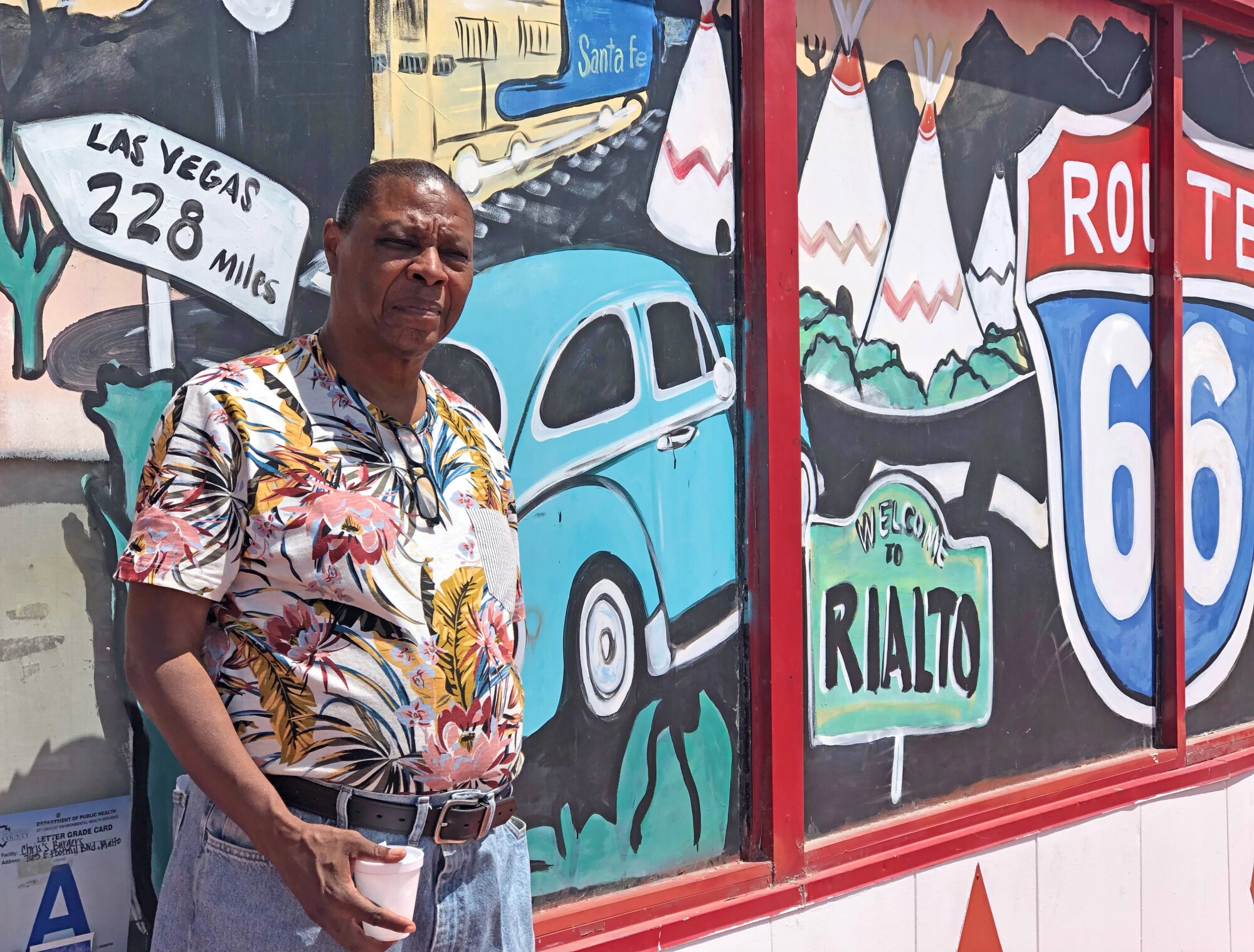
Wilbert Branigan, previously of Las Vegas, says exterior a Rialto diner that Black males can get alongside tremendous within the Inland Empire in the event that they work exhausting and thoughts their enterprise.
(Tyrone Beason / Los Angeles Occasions)
Branigan, who lives a brief drive east close to San Bernardino, says he’s sure that Black males within the Inland Empire like himself can nonetheless obtain an unbothered life in the event that they work exhausting and thoughts their enterprise.
Taking a look at ease in denim shorts and a T-shirt printed with tropical flowers, the long-haul truck driver, who’s 63 and initially from Las Vegas, leans in shut as if to disclose a secret.
“There’s stress on the land proper now, however can I say this truthfully?” Branigan whispers, his immaculately slicked-back hair glistening within the solar. “There’s a God above, and he’ll repair all issues. So I don’t fear.”

My charmed encounters with residents who find it irresistible right here compete with the much less glowing particulars I’m studying.
Black Californians within the early twentieth century constructed leisure resorts for themselves in scenic corners like Lake Elsinore, south of Riverside; and Apple Valley, not removed from Hesperia. It enrages me to assume that racial segregation was so entrenched that enclaves like these felt like paradise by comparability.
Within the quickly increasing metropolis of Beaumont, the place I brush previous households of various races on a tour of mannequin houses boasting cavernous dens, upstairs TV lounges, mountain views and costs within the $500,000-to-$700,000 vary, I can’t assist however be reminded of what actual property dealer April Schmidt and her colleagues shared with me.
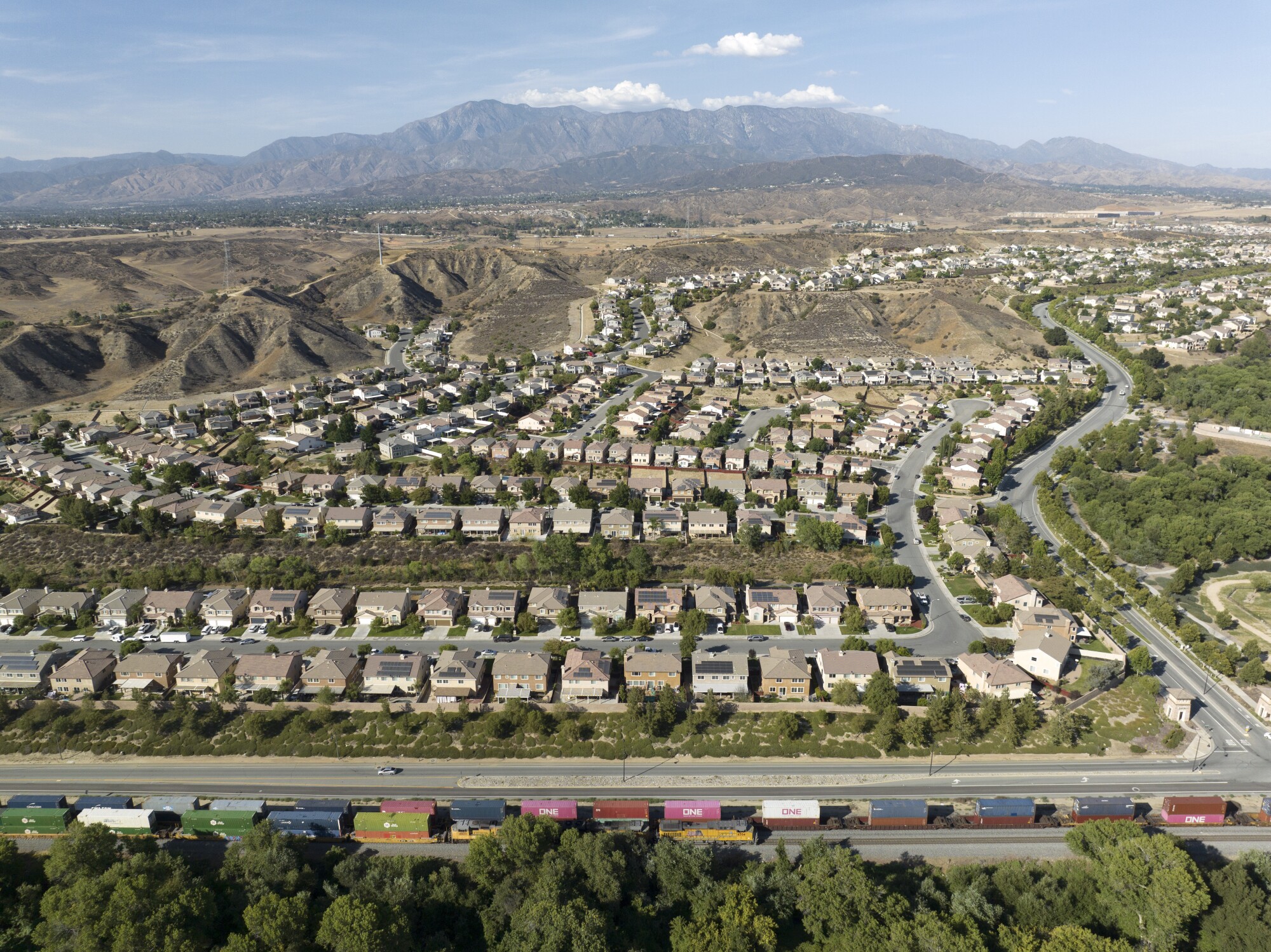
The rising Inland Empire metropolis of Beaumont and neighboring Banning had been as soon as separated by a metropolis road, with white individuals on one aspect and Mexican American and Black residents on the opposite.
(Myung J. Chun / Los Angeles Occasions)
A metropolis road that divided Beaumont and neighboring Banning as soon as separated the place white individuals lived from Mexican American residents in addition to Black transplants who’d been pressured out of what’s now downtown Palm Springs.
Fontana was so notorious for its tolerance of racism that when the present mayor, Acquanetta Warren, advised her father in 1993 that she was leaving Compton and relocating her household to the inland metropolis to flee the crime and racial stress of L.A., he questioned why she would “swap out gang-banging for Klan exercise.”
And a large section of the inhabitants can’t afford the numerous nice issues this area has to supply. I’ve pushed previous cell house parks and homeless encampments deep within the desert, out of sight of the flamboyant resorts of the Coachella Valley.
Within the enterprise and transit hub of San Bernardino, almost 1 / 4 of the inhabitants of greater than 222,000 lives in poverty.
Fatima’s work on the Middle for Social Innovation contains classes with residents of the Inland Empire to assemble enter that elected and enterprise leaders can use to enhance the standard of life.
The middle’s analysis backs up what she and her colleagues have heard anecdotally: Solely about 1 in 4 Inland Empire jobs pays sufficient for a household to cowl its primary wants, and stress is taking a toll on some individuals’s psychological well being.
Activists have lengthy complained that the unfold of warehouses in one of many nation’s busiest distribution hubs has resulted in elevated air air pollution and rampant exploitation of employees.
“Should you’re not sweating, you’re not working exhausting sufficient,” says Victor, 57, a Mexican American warehouse worker who’s been working within the trade for greater than 25 years.
He’s afraid of retribution from his employer, so he declines to share his final identify once we meet on the Warehouse Employee Useful resource Middle, a nonprofit advocacy group in Ontario.
He tells of getting to make use of defective gear, toiling in buildings that lacked air flow, going hours with no water break, being pressured to take additional time shifts and dealing a second job cleansing workplaces at evening in order that he and his spouse can present for themselves and their 10-year-old daughter.
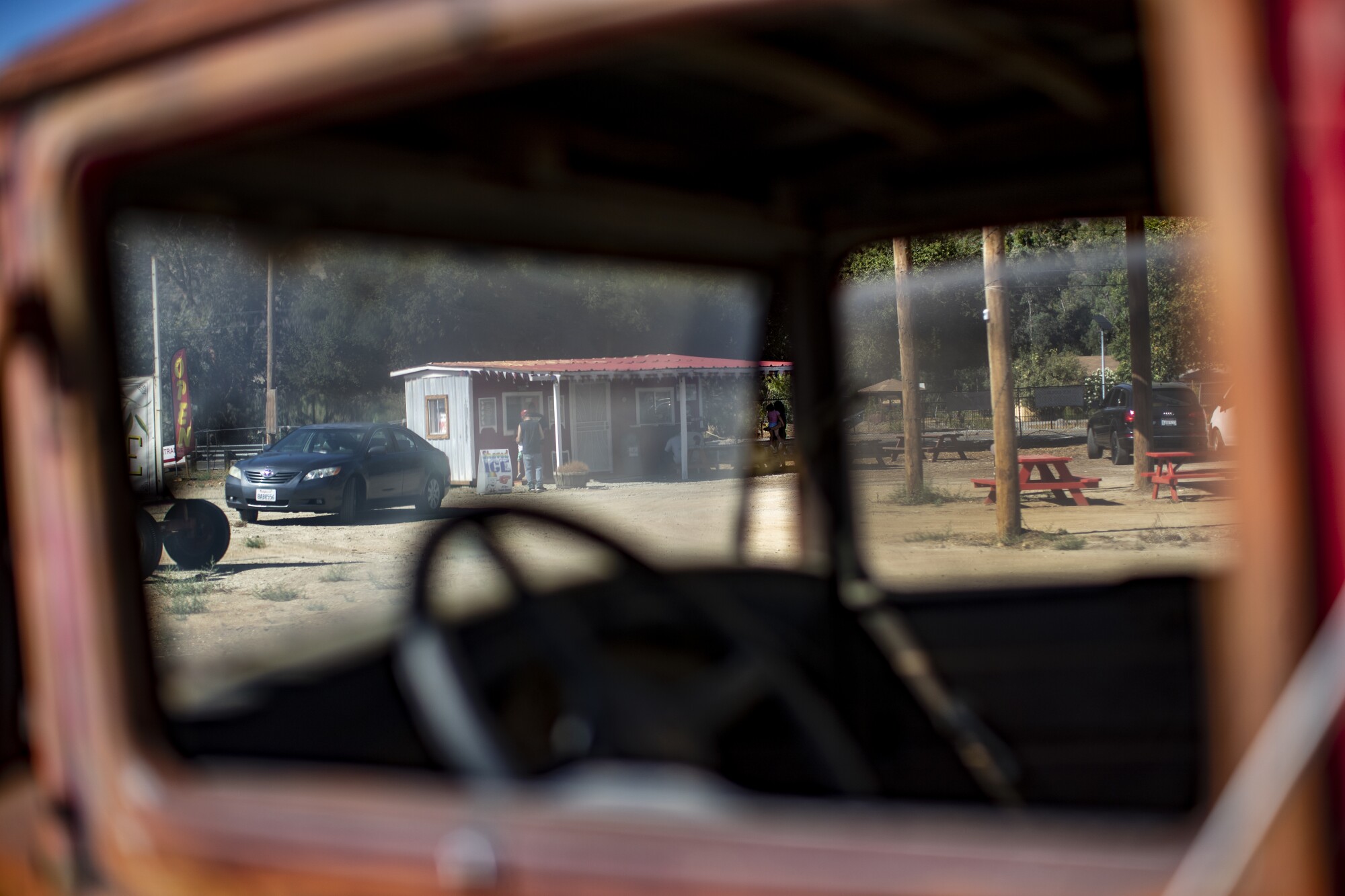
Prospects purchase lemonade and ice cream from a country retailer exterior Moreno Valley.
(Gina Ferazzi / Los Angeles Occasions)
“As soon as they’re finished with you,” he says in Spanish, his voice cracking, “on to the following.”
His eyes moisten with tears once I ask whether or not he’ll ever obtain the American dream residing this manner. Virtually inaudibly, he says no.
Victor’s tales hit me like a punch to the intestine. However once I relay what he advised me to Warren, Fontana’s first Black mayor, she scoffs at claims of widespread employee abuse and environmental harm.
Though in April town needed to enact new air air pollution guidelines for logistics facilities after being sued by the state for approving a trucking warehouse subsequent to a highschool, Warren contends that the primary menace to air high quality lies elsewhere: the heavy site visitors generated by motorists and vans from different communities passing by means of on the area’s many freeways.
The mayor, a Republican, has embraced the nickname that progressive critics of her enterprise improvement insurance policies have given her — “Warehouse Warren.”
She boasts of town’s simple commutes to jobs with residing wages.
Sitting at a group middle that has a indifferent aquatic facility, Warren, 65, recounts driving by means of the Inland Empire within the early Nineteen Nineties and being moved by the sight of kids taking part in on sidewalks and in pristine parks.
She felt her younger youngsters deserved that, too. And he or she wasn’t going to let herself be discouraged by the truth that native Ku Klux Klan members used to parade by means of the streets, or that for years Black individuals had been forbidden to enterprise south of Baseline Avenue, a major east-west thoroughfare.
Warren says she watched the Watts rebellion unfold from her entrance porch as just a little woman, however that doesn’t maintain her from reciting a lesson her dad and mom taught her: “That is America; it’s for everybody.”
I inform Warren that I’m disturbed by tales about Inland Empire residents feeling ignored by their elected leaders and endangered attributable to firms that she and different officers have welcomed.
“With all I’ve gone by means of,” Warren says sternly, “why would I would like different individuals to undergo?
“We’re not making an attempt to create havoc for individuals.”
Warren and I agree on one primary reality: We individuals of coloration have managed to stamp our identities on essentially the most hostile of settings. We’ll ourselves to like locations that present no love for us.
That’s what I imagine is occurring to those that’ve chosen to place down roots within the Inland Empire.
Inquisitive about how different individuals of coloration are making their mark on the area, I go to the newly opened Cheech Marin Middle for Chicano Artwork & Tradition in downtown Riverside to see what it may inform me concerning the affect of Mexican Individuals on this area. Strolling from gallery to gallery, I really feel as if I’m floating by means of the collective consciousness of a complete individuals.
The works on show — murals and mobiles, blown glass and resin items, and monolithic holograms whose photographs morph as you stroll previous them — concurrently extol and mock the melding of Indigenous cultures and the Catholicism that was pressured on the unique civilizations of the Americas.
A portray by Eloy Torrez reveals Cheech Marin, the comic and major benefactor himself, carrying a crown and surrounded by seagulls in flight as he stands above the Pacific Ocean.
The title: “It’s a Brown World After All.”
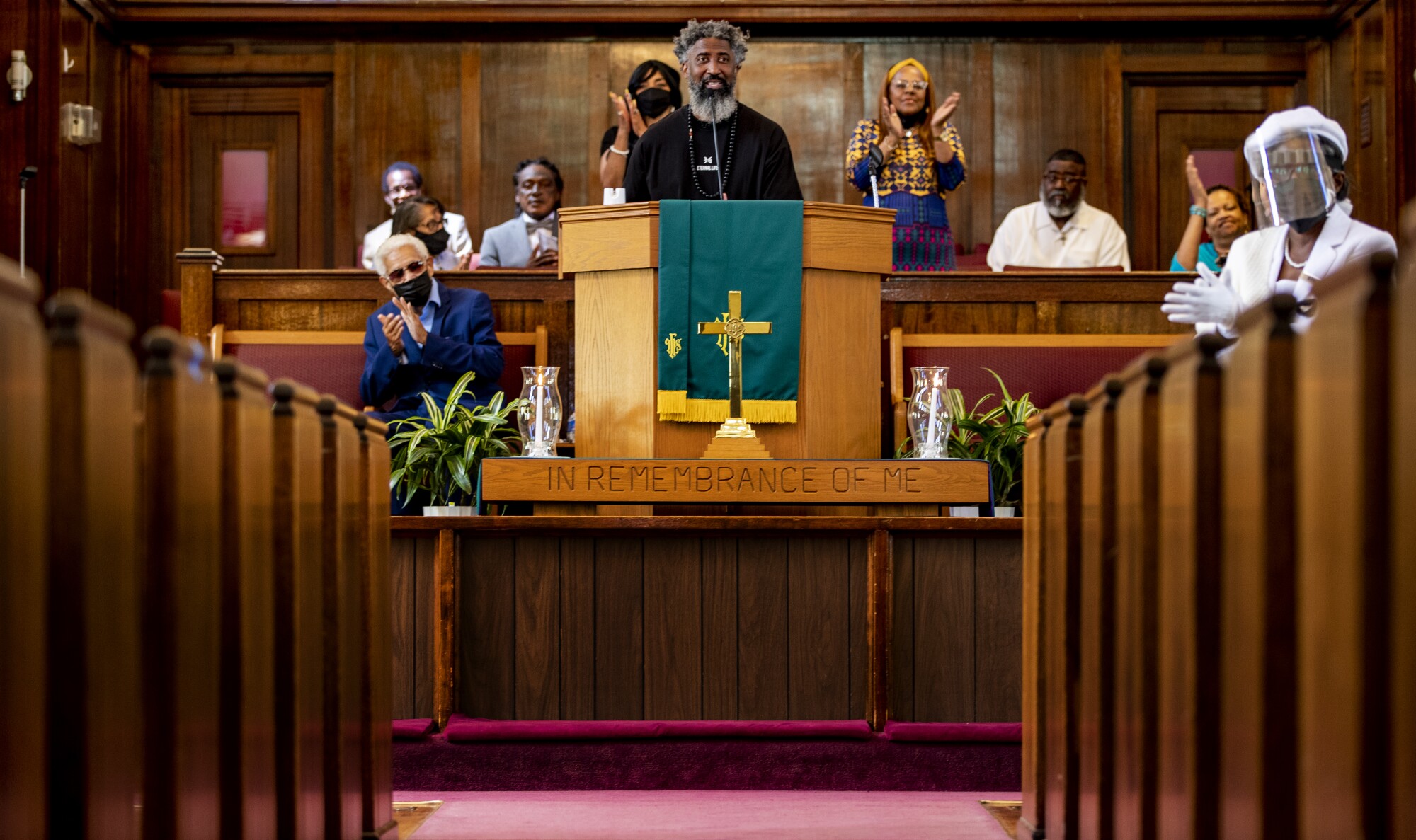
“Each time your baby leaves house, they’re at risk of dying,” Pastor Barry Settle stated in a current sermon at Allen Chapel AME Church in Riverside, pointing to current racist massacres whereas celebrating Juneteenth.
(Gina Ferazzi / Los Angeles Occasions)
Throughout my exploration of the realm, I drive by means of grassy hillsides bursting with yellow flowers alongside Freeway 71 in Chino Hills. Swiftly, I’m handled to a spectacular sight: the intricately carved pink stone domes and towers of the Shri Swaminarayan Mandir, a 20-acre Hindu temple complicated, effervescent up above the encircling warehouses. It makes this born-and-raised Baptist marvel on the sheer audacity of those that constructed it proper by the aspect of the street, the place everybody could be awed by it.
Black church buildings like Allen Chapel — an African Methodist Episcopal church in Riverside that’s tucked away on a aspect road lined with Craftsman and Victorian bungalows decked with flowers — have served to anchor residents in a much less flashy however equally important means.
Quickly after transferring right here, Fatima heard about Allen Chapel Pastor Barry Settle’s means of weaving present points into his sermons. She joined the congregation, however the pandemic typically pressured her to look at its providers from house on a livestream.

Allen Chapel African Methodist Episcopal Church in Riverside has develop into one anchor for Black residents who’ve relocated to the Inland Empire.
(Gina Ferazzi / Los Angeles Occasions)
On Juneteenth, which fell on a Sunday this 12 months, Settle’s voice crescendos and dives, and worshipers elevate their arms to the ceiling, as he commemorates the top of slavery within the U.S. That is additionally a day of remembrance for traumas inflicted in our personal time.
I shake my head in disgrace for this nation as Settle honors the 9 Black worshipers at Mom Emanuel AME Church in Charleston, S.C., who had been shot lifeless by a white supremacist in 2015, and the victims of two gun massacres in Might: the racially motivated killing of 10 Black Individuals at a grocery store in Buffalo, N.Y., and the homicide of 19 schoolchildren and two lecturers in Uvalde, Texas, a predominantly Latino city.
“Our kids can’t go to highschool. Our kids can’t go to church. Our kids can’t go to the grocery retailer,” Settle tells the congregation, his voice rising in anger. “Each time your baby leaves house, they’re at risk of dying.”
Settle, 55, an L.A. native, says it may be a problem to reassure and encourage his flock provided that the nation’s turmoil at occasions feels prefer it’s closing in on them.
“Peace doesn’t imply the absence of issues,” he says. “It’s safety, even within the midst of the issues we face in society.”

As I bow my head in prayer at Allen Chapel and hearken to worshipers moan to launch their worries, I really feel so pleased with my individuals’s willpower to do greater than merely carry on maintaining on.
On a 101-degree afternoon, the Nelsons and I sit underneath a shade tree of their entrance yard and watch the youngest baby, Tariq, playfully transfer from one relative’s lap to a different.
Regardless of my reservations, I’ve to just accept that the Inland Empire has given this household a sort of freedom that many people want for and by no means discover.
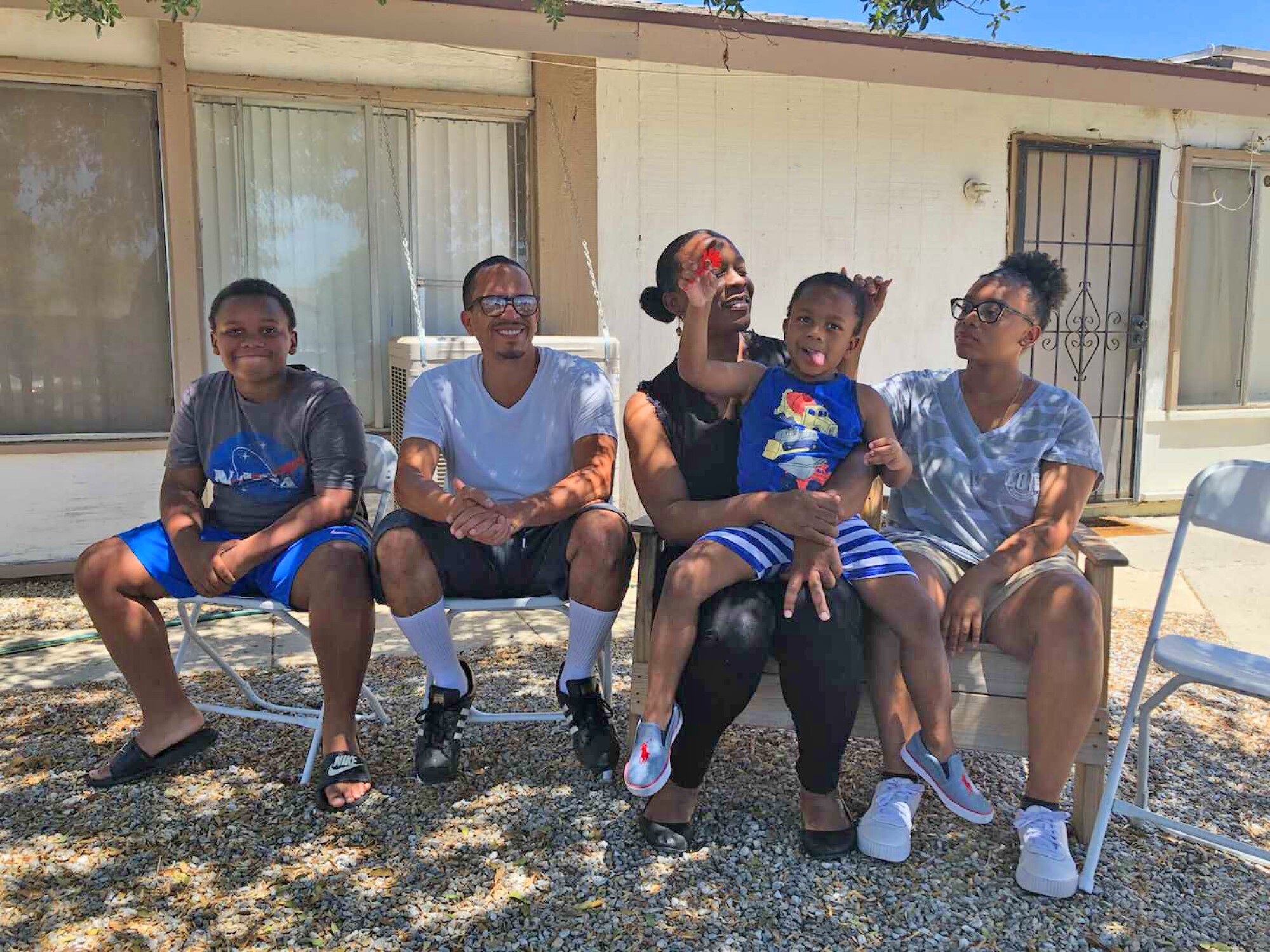
“My husband and I made a decision that we’ll traumatize them no extra,” Fatima Nelson says of pulling their eldest youngsters from Lengthy Seaside faculties that had few Black college students. Right here, she and husband Arthur Nelson II loosen up exterior their Moreno Valley house with Arthur III, Tariq and Julia, from left.
(Tyrone Beason / Los Angeles Occasions)
Generally Fatima will awaken at daybreak, stroll exterior to the again patio and “simply watch the solar rise.”
Grinning and unfazed by the warmth, Fatima says she continually reminds her youngsters to understand the place they now reside — to treasure the open skies and the serenity that their father raves about, a quiet so profound that on this afternoon, we are able to hear birds singing within the distance.
Fatima turns to Julia.
“What do I say on a regular basis?” she asks her daughter. “Let the breeze wash over your pores and skin.”
So we pay attention as a gust rustles the leaves, and let a peaceful, that feels as if it’s been gathering for longer than any of us can measure, wash over all of us.



